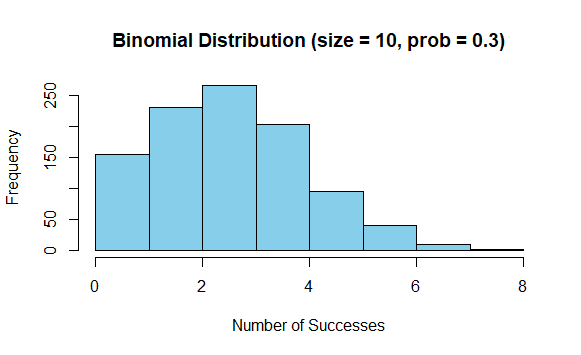Parameters of rbinom() in R
Last Updated :
23 Jul, 2025
The rbinom() function in R is used to generate random numbers from a binomial distribution. The binomial distribution models the number of successes in a fixed number of independent Bernoulli trials, each with the same probability of success. This function is useful for simulating scenarios where you have a series of yes/no, true/false, or success/failure outcomes.
What is the rbinom() Function?
The rbinom() function generates random numbers that follow a binomial distribution. The function syntax is as follows:
rbinom(n, size, prob)
- n: Number of observations to generate (sample size)
- size: Number of trials (number of attempts or experiments)
- prob: Probability of success in each trial
Let's break down these parameters in detail:
n: Number of Observations- This parameter defines the number of random values you want to generate from the binomial distribution.
- For example, if
n = 10, rbinom() will generate 10 random numbers following the binomial distribution.
size: Number of Trials- The
size parameter represents the number of independent trials (or experiments) for each observation. - It defines how many trials will be conducted in the experiment, which means how many times you flip a coin, roll a die, or perform a similar activity.
- Example: If
size = 5, it means 5 trials are conducted for each observation.
prob: Probability of Success- This parameter specifies the probability of success for each trial, i.e., the likelihood of a 'success' occurring in each experiment.
- The value of
prob should be between 0 and 1. - Example: If
prob = 0.3, there is a 30% chance of success in each trial.
Now we will discuss different Parameters of rbinom() in R Programming Language.
Example 1: Generating Random Numbers from a Binomial Distribution
Let’s generate 10 random numbers from a binomial distribution with 5 trials and a success probability of 0.5.
R
# Generating 10 random numbers with 5 trials and 50% probability of success
set.seed(123) # Setting seed for reproducibility
random_numbers <- rbinom(n = 10, size = 5, prob = 0.5)
print(random_numbers)
Output:
[1] 2 3 2 4 4 1 3 4 3 2
- Here,
n = 10 means we generated 10 random values. size = 5 means each of these values comes from an experiment with 5 trials.prob = 0.5 indicates a 50% chance of success in each trial.
Example 2: Visualizing the Distribution of Random Numbers
Let’s visualize the distribution of 1000 random numbers generated with 10 trials and a 0.3 probability of success.
R
# Generating 1000 random numbers
random_numbers <- rbinom(n = 1000, size = 10, prob = 0.3)
# Visualizing the distribution using a histogram
hist(random_numbers, breaks = 10, col = "skyblue", main = "Binomial Distribution (size = 10, prob = 0.3)",
xlab = "Number of Successes", ylab = "Frequency")
Output:
 Parameters of rbinom() in R
Parameters of rbinom() in RThe histogram shows the distribution of successes across 1000 experiments, each with 10 trials and a 30% chance of success.
Common Use Cases and Applications
The rbinom() function has multiple applications, especially in fields such as:
- Simulating Experiments
- Used in scenarios where you want to simulate the outcomes of an experiment involving repeated trials, such as flipping a coin or rolling a die.
- Useful in understanding the likelihood of different outcomes over many trials.
- Quality Control in Manufacturing
- Used in simulating the probability of defective items in a production line.
- Helps model the number of defective products detected in batches.
- Clinical Trials and Research
- Common in biostatistics to simulate the number of patients responding to a treatment in a clinical trial.
- Allows researchers to estimate the probability of success or failure in medical experiments.
- Education and Academia
- Widely used in teaching probability and statistics, providing practical examples of binomial distributions.
Conclusion
The rbinom() function generates random numbers following a binomial distribution, based on specified parameters: n, size, and prob.
- This function is highly versatile and can simulate various scenarios, such as coin tosses, quality control, clinical trials, and educational demonstrations.
- Understanding how to use
rbinom() is essential for conducting simulations and modeling experiments in R.
By mastering the rbinom() function, you will be able to simulate binomial distributions effectively and gain deeper insights into probability-based experiments. It is a powerful tool in R for anyone working with statistical simulations or requiring probabilistic modeling.